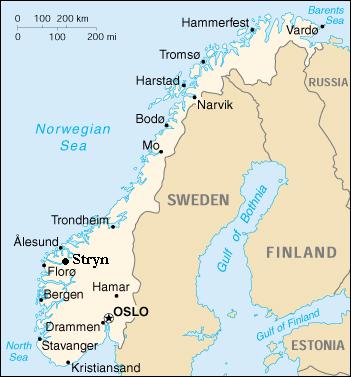

All About Norway and Stryn |
 Norway
Norway
Norway has a total area of 324,200 sq km, which slighty larger then New Mexico. It shares boundaries with Finland, Sweden, and Russia. Norway's coastline includes large islands,long fjords, numerous small islands, and minor indentations. The climate of Norway is temperate along coast, modified by North Atlantic Current; colder in the interior; and rainy year-round on west coast. Norway is very glaciated with high plateaus and rugged mountains broken by fertile valleys; small, scattered plains; coastline deeply indented by fjords; arctic tundra in north. Natural resources include: petroleum, copper, natural gas, pyrites, nickel, iron ore, zinc, lead, fish, timber, and hydropower. (http://www.cia.gov/cia/publications/factbook/index.html) |
In the western part of Norway lies the little town of Stryn located on the Nordfjord. This is the town in which I will be living and studying. Stryn lies innermost in Nordfjord where the mountains ascend to the glacier. To see 360 degree images of Stryn, click Here It has a population of roughly 3,000. Agriculture, fishing, small-scale industry, and tourism are the most important means of making a living in Stryn. The Stryn municipality (county)comprises several separate communities. At the far end of the fjord lie Loen and Olden with their valleys leading towards the Jostedalsbreen Glacier. To view a live image via webcam of Stryn go Here. There are lots of activities on offer, many of the most exciting ones linked to the glacier with its summer ski centre and glacier walks. Tourists have been coming to these communities since the 1860s and there is a long tradition of looking after visitors. The linden leaves in the municipal crest are there because of the fact that Northern Europe's largest linden wood is situated in Flostranda in Stryn. Click Here for more information on attractions in Stryn. To see a map of Nordfjord click Here. |
A population of 4,438,547 (July 1999 est.) make up the friendly nation of Norway. Norwegians come from two ethnic groups: Germanic (Nordic, Alpine, Baltic) and Lapps (Sami) 20,000 people. Religions of Norway include: Evangelical Lutheran 87.8% (state church), other Protestant and Roman Catholic 3.8%, none 3.2%, unknown 5.2% (1980). The official Language is Norwegian, but there are small Lapp and Finnish speaking minorities to the North. |
